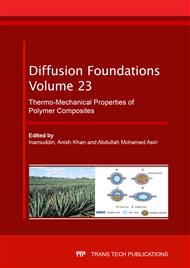[1]
K.S. Rahman, M.N. Islam, M.M. Rahman, M.O. Hannan, R. Dungani, H.P.S.A. Khalil, Flat-pressed wood plastic composites from sawdust and recycled polyethylene terephthalate (PET): physical and mechanical properties, Springerplus. 2 (2013) 629.
DOI: 10.1186/2193-1801-2-629
Google Scholar
[2]
D.J. Gardner, Y. Han, L. Wang, Wood--Plastic Composite Technology, Curr. For. Reports. 1 (2015) 139–150.
DOI: 10.1007/s40725-015-0016-6
Google Scholar
[3]
Forest Products Laboratory - USDA, Wood Handbook: Wood as an Engineering Material, 2010. doi:General Technical Report FPL-GTR-190.
Google Scholar
[4]
A. Gebhardt, Understanding Additive Manufacturing, 2011.
DOI: 10.3139/9783446431621
Google Scholar
[5]
M. Ibrahim, N.S. Badrishah, N. Sa'ude, M.H.I. Ibrahim, Sustainable Natural Bio Composite for FDM Feedstocks, Appl. Mech. Mater. 607 (2014) 65–69.
DOI: 10.4028/www.scientific.net/AMM.607.65
Google Scholar
[6]
B. Wendel, D. Rietzel, F. Kühnlein, R. Feulner, G. Hülder, E. Schmachtenberg, Additive processing of polymers, Macromol. Mater. Eng. 293 (2008) 799–809.
DOI: 10.1002/mame.200800121
Google Scholar
[7]
K. Jiang, Y. Guo, D.L. Bourell, Study on the microstructure and binding mechanisms of selective laser sintered wood plastic composite, in: 24th Int. Solid Free. Fabr. Symp. - An Addit. Manuf. Conf. SFF 2013, 2013: p.497–504. http://www.scopus.com/inward/record.url?eid=2-s2.0-84898402494&partnerID=40&md5=acc73ea6c6b24a7fc1add58b81ec9839.
Google Scholar
[8]
Q. Cheng, L. Muszynski, S. Shaler, J. Wang, Microstructural Changes in Wood Plastic Composites Due to Wetting and Re-drying Evaluated by X-ray Microtomography, J. Nondestruct. Eval. 29 (2010) 207–213.
DOI: 10.1007/s10921-010-0078-0
Google Scholar
[9]
N.M. Stark, D.J. Gardner, Outdoor durability of wood-polymer composites, Wood-Polymer Compos. (2008) 142–165.
DOI: 10.1533/9781845694579.142
Google Scholar
[10]
S. V Rangaraj, L. V Smith, Effects of Moisture on the Durability of a Wood/Thermoplastic Composite, J. Thermoplast. Compos. Mater. 13 (2000) 140–161.
DOI: 10.1177/089270570001300204
Google Scholar
[11]
C.S. George, G.F. Smith, I.H. Marshall, J.J. Wu, Composite Material Response: Constitutive relations and damage mechanisms, Springer Netherlands, (1988).
Google Scholar
[12]
Q. Cheng, J. Wang, S.M. Shaler, Mechanical Performances of Wood Polypropylene Composite due to Extended Moisture Immersion, J. Thermoplast. Compos. Mater. 22 (2009) 321–333.
DOI: 10.1177/0892705708098156
Google Scholar
[13]
T.L. Jose, P.C. Thomas, K. Jayanarayanan, J. Mathew, K. Joseph, Solvent Uptake and Accelerated Ageing Studies of Cotton-Polypropylene Commingled Composite Systems, Polym. Polym. Compos. 18 (2010) 103–112.
DOI: 10.1177/096739111001800206
Google Scholar
[14]
C. Clemons, Wood-plastic composites in the United States: the interfacing of two industries, Prod J. 52 (2002).
Google Scholar
[15]
K.B. Adhikary, S. Pang, M.P. Staiger, Dimensional stability and mechanical behaviour of wood-plastic composites based on recycled and virgin high-density polyethylene (HDPE), Compos. Part B Eng. 39 (2008) 807–815.
DOI: 10.1016/j.compositesb.2007.10.005
Google Scholar
[16]
S. Karumuri, S. Hiziroglu, A.K. Kalkan, The distribution and role of nanoclay in[space]lignocellulose-polymer blends, RSC Adv. 7 (2017) 19406–19416.
DOI: 10.1039/C7RA02082A
Google Scholar
[17]
V. Steckel, C.M. Clemons, H. Thoemen, Effects of material parameters on the diffusion and sorption properties of wood-flour/polypropylene composites, J. Appl. Polym. Sci. 103 (2007) 752–763.
DOI: 10.1002/app.25037
Google Scholar
[18]
W.V. Srubar, S.L. Billington, A micromechanical model for moisture-induced deterioration in fully biorenewable wood–plastic composites, Compos. Part A Appl. Sci. Manuf. 50 (2013) 81–92.
DOI: 10.1016/j.compositesa.2013.02.001
Google Scholar
[19]
I. Ghasemi, B. Kord, Long-term Water Absorption Behaviour of Polypropylene/Wood Flour/Organoclay Hybrid Nanocomposite, Iran. Polym. J. 18 (2009) 683–691.
Google Scholar
[20]
M.N. Ichazo, C. Albano, J. González, R. Perera, M. V. Candal, Polypropylene/wood flour composites: Treatments and properties, Compos. Struct. 54 (2001) 207–214.
DOI: 10.1016/S0263-8223(01)00089-7
Google Scholar
[21]
S.K. Najafi, A. Kiaefar, E. Hamidina, M. Tajvidi, Water Absorption Behavior of Composites from Sawdust and Recycled Plastics, J. Reinf. Plast. Compos. 26 (2007) 341–348.
DOI: 10.1177/0731684407072519
Google Scholar
[22]
R. Liu, J. Cao, Y. Chen, Stress relaxation of composites made of polypropylene and organo-montmorillonite modified wood flour during water immersion, Holzforschung. 71 (2017) 163–170.
DOI: 10.1515/hf-2016-0116
Google Scholar
[23]
S. Seethamraju, P.C. Ramamurthy, G. Madras, Performance of an ionomer blend-nanocomposite as an effective gas barrier material for organic devices, RSC Adv. 4 (2014) 11176.
DOI: 10.1039/c3ra47442a
Google Scholar
[24]
R. Liu, S. Luo, J. Cao, Y. Peng, Characterization of organo-montmorillonite (OMMT) modified wood flour and properties of its composites with poly(lactic acid), Compos. Part A Appl. Sci. Manuf. 51 (2013) 33–42.
DOI: 10.1016/j.compositesa.2013.03.019
Google Scholar
[25]
C. Xu, C. Xing, H. Pan, L.M. Matuana, H. Zhou, Hygrothermal aging properties of wood plastic composites made of recycled high density polypropylene as affected by inorganic pigments, Polym. Eng. Sci. 55 (2015) 2127–2132.
DOI: 10.1002/pen.24054
Google Scholar
[26]
G.W. Beckermann, K.L. Pickering, Engineering and evaluation of hemp fibre reinforced polypropylene composites: Fibre treatment and matrix modification, Compos. Part A Appl. Sci. Manuf. 39 (2008) 979–988.
DOI: 10.1016/j.compositesa.2008.03.010
Google Scholar
[27]
Y.-H. Cui, X.-X. Wang, Q. Xu, Z.-Z. Xia, Research on Moisture Absorption Behavior of Recycled Polypropylene Matrix Wood Plastic Composites, J. Thermoplast. Compos. Mater. 24 (2011) 65–82.
DOI: 10.1177/0892705710376470
Google Scholar
[28]
C. J??rdens, S. Wietzke, M. Scheller, M. Koch, Investigation of the water absorption in polyamide and wood plastic composite by terahertz time-domain spectroscopy, Polym. Test. 29 (2010) 209–215.
DOI: 10.1016/j.polymertesting.2009.11.003
Google Scholar
[29]
S. Tamrakar, R.A. Lopez-Anido, Water absorption of wood polypropylene composite sheet piles and its influence on mechanical properties, Constr. Build. Mater. 25 (2011) 3977–3988.
DOI: 10.1016/j.conbuildmat.2011.04.031
Google Scholar
[30]
M.A. Khan, M.S. Rahman, Moisture Sorption Isotherms of Wood and Wood-Plastic Composites (WPC), Polym. Plast. Technol. Eng. 30 (1991) 435–440.
DOI: 10.1080/03602559108019211
Google Scholar
[31]
M.A. Khan, K.M.I. Ali, Effect of Moisture and Heat on Mechanical Properties of Wood and Wood-Plastic Composite, Polym. Plast. Technol. Eng. 32 (1993) 5–13.
DOI: 10.1080/03602559308020151
Google Scholar


